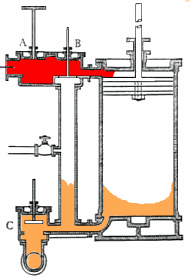The R. Trevithick engine named "Cornwall"

The steam (at 3-4 kg/cm²), was admitted in the cylinder only for 1/10 or 1/5 of the active stroke.
When the inlet valve is closed, the piston continues its active stroke by steam expansion.
When the piston reaches the bottom of the stroke an equilibrium valve opens to allow the steam to pass from above to below it.
The pressure above and below the piston is now equallized.
The upstroke is assisted by the crossbeam and the descent (by gravity) of the very heavy pump piston and rod.
When the piston has almost completed the upstroke, the equilibrium valve closes to make a steam cushion which reduces impact vibration.
The exhaust valve opens before the inlet valve opens.
The beam moves slightly under vacuum pressure alone and then accelerates greatly when the inlet valve opens.
In the cylinder below the piston, through a connection to the condenser, a partial vacuum is created. This assists the steam pressure above to drive the piston down, increasing the engine's efficiency.